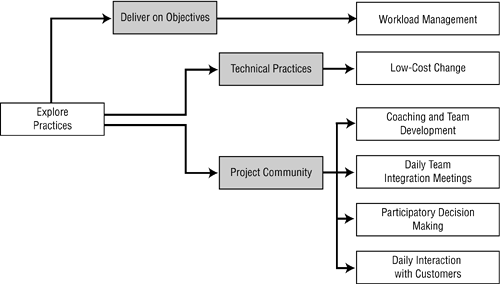Individual Performance
Phase Explore
A complex adaptive system (CAS) is a collection of agents who explore to achieve a goal (fitness in a biological sense) by interacting with each other according to a set of rules. A CAS experiments with alternatives, selects and executes viable ones, compares the results against its fitness goals (the system's objectives), and adapts as necessary. Extending this metaphor to a project team, the project manager's job takes on new dimensionsto constantly help the team articulate and understand the goal and the constraints, to help the team interact effectively, to facilitate the decision-making process, to ensure appropriate feedback is being gathered and incorporated into the next iteration, and to keep score and deal with reality when things go off track, as every project does.
The CAS model defines a useful metaphor for a leadership-collaboration management style, one that encourages emergent (innovative), risk-taking behavior. Seen in this light, the key project management tasks become establishing a vision and creating a collaborative work environment. The practices in this chapter are focused on the latter objective. The purpose of the Explore phase is to deliver tested , accepted features. Rather than concentrate on the technical details of how to accomplish this goal, however, the agile project manager focuses on creating self-organizing , self-disciplined teams that can best deliver on the ultimate product goal.
Many individuals, even some in the agile community, think agile project management equates to less management. In my experience, adaptive, leadership-collaboration management may be different, but it is certainly not less time consuming. The people management aspectsdecision making, coaching, facilitating, working with customers and stakeholdersare a significant load on the project manager's time. As authors Marcus Buckingham and Curt Coffman (1999) write, based on extensive research (interviews with over 80,000 managers during the last 25 years ), "The manager role is to reach inside each employee and release his unique talents into performance."
The project manager, in her role as coach and team builder, contributes in six key ways to project success:
- Focusing the team on delivering results
- Molding a group of individuals into a team
- Developing each individual's capabilities
- Providing the team with required resources and removing roadblocks
- Coaching the customers
- Orchestrating the team's rhythm
The essence of an agile project manager's role is not creating Gantt charts or status reports (although doing that remains a part of her work); it is creating a high-performance exploration team from a group of individuals. Exploration and experimentation, the foundations of new product development, involve the risk of making mistakesof failingand then learning from those mistakes. Managers must respond by making risk taking, well, less risky. As authors Rob Austin and Lee Devin (2003) note, "Artful managers must also do their part; they must create conditions in which makers can work at risk. Willingness to work at risk is vital in artful making, in part because exploration is uncomfortable." While team members themselves must participate in these activities, the project manager's role is to make sure they happen. It is a difficult, never-ending , and ultimately rewarding role.
While all the practices in this phase are project management ones, two are geared to team members (workload management, low-cost change), while others are geared to project managers (e.g., coaching and team development). The Explore phase practices fall into three categories, as shown in Figure 7.1:
Figure 7.1. Explore Phase Practices

Deliver on Vision and Objectives
- Workload management
Technical Practices
- Low-cost change
Project Community
- Coaching and team development
- Daily team integration meetings
- Participatory decision making
- Daily interactions with the customer team
The Agile Revolution
- Innovative Product Development
- Reliable Innovation
- Core Agile Values
- Agile Project Management
- Thriving in a Chaordic World
- Our Journey
Guiding Principles: Customers and Products
- Herman and Maya
- The Guiding Principles of Agile Project Management
- Deliver Customer Value
- Employ Iterative, Feature-Based Delivery
- Champion Technical Excellence
- Customers and Products
Guiding Principles: Leadership-Collaboration Management
- Management Style
- The Business of APM
- Leadership-Collaboration Management
- Encourage Exploration
- Build Adaptive (Self Organizing, Self Disciplined) Teams
- Simplify
- Principles to Practices
An Agile Project Management Model
- Principles and Practices
- An Agile Process Framework
- Phase: Envision
- Phase: Speculate
- Phase: Explore
- Phase: Adapt
- Phase: Close
- Judgment Required
- Project Size
- Agile Practices
The Envision Phase
- Get the Right People
- Phase: Envision
- Practice: Product Vision Box and Elevator Test Statement
- Practice: Product Architecture
- Practice: Project Data Sheet
- Practice: Get the Right People
- Practice: Participant Identification
- Practice: Customer Team-Developer Team Interface
- Practice: Process and Practice Tailoring
- Envision Summary
The Speculate Phase
- Scope Evolution
- Phase: Speculate
- Practice: Product Feature List
- Practice: Feature Cards
- Practice: Performance Requirements Cards
- Practice: Release, Milestone, and Iteration Plan
- Speculate Summary
The Explore Phase
- Individual Performance
- Phase: Explore
- Practice: Workload Management
- Practice: Low-Cost Change
- Practice: Coaching and Team Development
- Practice: Daily Team Integration Meetings
- Practice: Participatory Decision Making
- Practice: Daily Interaction with the Customer Team
- Explore Summary
The Adapt and Close Phases
- Progress
- Phase: Adapt
- Practice: Product, Project, and Team Review and Adaptive Action
- Phase: Close
- Adapt and Close Summary
Building Large Adaptive Teams
- An Achilles Heel?
- The Scaling Challenge
- A Scaled Adaptive Framework
- A Hub Organizational Structure
- Self-Organization Extensions
- Team Self-Discipline
- The Commitment-Accountability Protocol
- Is It Working?
- Structure and Tools
- Summary
Reliable Innovation
EAN: 2147483647
Pages: 96
